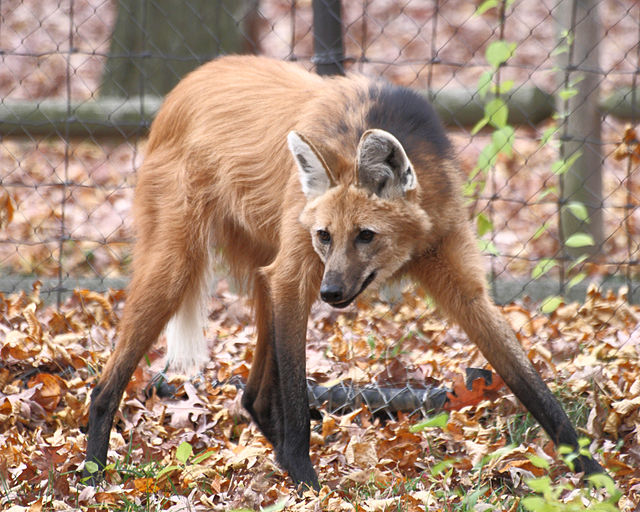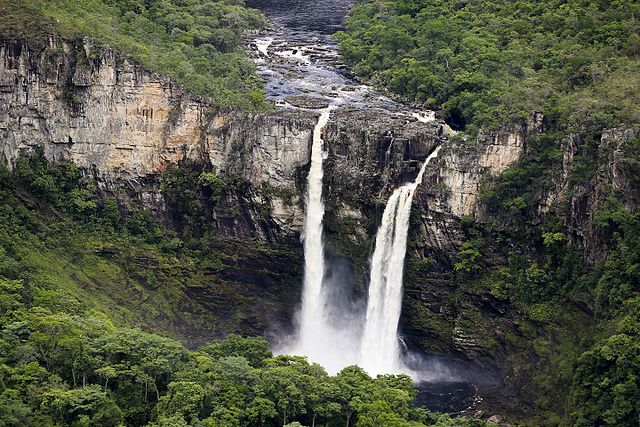Historically, human-wildlife relationships have been based on utilitarian values and emotions such as affection and fear. Throughout the world, different wild animals arouse empathy and awe. Due to the feelings these animals evoke, they have become symbols of environmental protection efforts—the image of Polar Bears triggers concerns about climate change, and Jaguars and Blue Macaws raise attention to deforestation in the Brazilian Amazon and Atlantic Forest. While these species and the issues they represent are well-known across the globe, another animal—the Maned Wolf—and the problems it symbolizes remain in the shadows.
The Maned Wolf is unique. With erect ears, reddish fur, bushy mane, and long, dark legs, the animal appears to be an amalgam of a fox, a dog, a wolf, and a deer. Despite its name, the Maned Wolf is not a true wolf. It is a solitary animal more closely related to the Bush Dog and is the only species belonging to the genus Chrysocyon. Having evolved to peer over the grasslands where it perambulates, it is the world’s tallest canid, standing up to roughly 35 inches at the shoulders. While the Maned Wolf is a hunter—and behaves like a cat when ambushing the prey—50 to 75% of its diet consists of native fruits. Defecating the seeds of these fruits over large distances, the animal is an important seed disperser.
Another facet of the Maned Wolf is the ability to ignite natural fires through the friction of its fur with the dry vegetation. These fires are fundamental for ecological equilibrium, especially because many plant species require heat to germinate. The Maned Wolf thus helps to preserve and restore the regions where it lives. That is especially crucial in the ecosystem 90% of Maned Wolves inhabit, the Brazilian Cerrado.
Much like the Maned Wolf, the Cerrado is remarkable, yet little known. The ecosystem occupies 24% of the Brazilian territory and is known as the richest neotropical savanna in the world. The classification of the Cerrado as a savanna nonetheless enshrouds the diversity of habitats encompassed in the region. These include forest, savanna, and natural grasslands formations. Forty-five million years of natural history and evolution and a mix of habitats for fauna and flora have favored high diversity levels in the region, which hosts approximately 160,000 different plant, animal, and fungi species. Because of the deep root system that characterizes the local native vegetation, the Cerrado is also known as an “upside-down” forest. Besides storing Carbon, this root system facilitates water infiltration, water retention, and the replenishment of aquifers. Because of these ecosystem functions, the Cerrado supplies eight out of the twelve hydrographic regions of Brazil.
Despite the richness and social-ecological importance of this Brazilian ecosystem, 49% of its native vegetation has been removed. The expansion of large-scale agribusiness farms has been leading to the loss of natural vegetation in the region. These dynamics started to happen in the late 1960s and continue to unfold to comply with increasing global demands for food and feed. Brazil is, at present, the world’s largest beef exporter and, together with the United States, accounts for over 80% of global soy exports. So that the country can hold these positions, areas occupied by pasturelands and croplands augment each year. Currently, the Cerrado hosts 40 million cattle heads and roughly 17 million hectares of croplands, out of which 90% are soy plantations.
Roughly 75% of soy produced in the Cerrado is used to feed livestock in and outside Brazil—especially in China and Europe—while only ~4% becomes products like milk, miso, tofu, and other meat replacements. The remaining 21% of soy grown in the Cerrado is transformed into oil. Soybean oil is used in the food industry (~60% for frying, baking, butter, and dressings), as biodiesel (~30%), and in the making of paints, textiles, plastics, solvents and spray-foam insulation (~10%). Soy cultivated in the Cerrado and destined for feeding humans is mainly consumed in Brazil and China, while that used as biodiesel and for industrial purposes reaches different markets across the world.
As such, global consumption patterns trigger the expansion of soy plantations in the Cerrado and the social-ecological disturbances associated with this phenomenon. These disturbances include the loss of natural vegetation, causing habitat fragmentation, biodiversity loss, disruptions in the water cycle, water scarcity, Carbon Dioxide (CO2) releases, loss of soil fertility, and erosion. The expansion of soy plantations also requires the use of toxic fertilizers, herbicides, and pesticides. These damage pollinators, the soil, watersheds, and are a peril to human and non-human health. Moreover, even if croplands expand throughout areas previously used as pasturelands, this results in the removal of the trees usually left standing to provide shade for the cattle. These land-cover change dynamics also hinder ecosystem restoration efforts.
The expansion of soy plantations and its consequences particularly threaten the Maned Wolf, especially by way of habitat fragmentation and road-kill incidents. (The expansion of croplands also stimulates the conversion of natural vegetation formations to roadways, which perforate the areas where wild animals rove.) The rapid decrease of the Maned Wolf’s population size and density has caught the attention of biologists and conservationists. The International Union for Conservation of Nature (IUCN) red list of threatened species classifies the animal as nearly threatened. The Brazilian Institute of the Environment and Natural Resources (IBAMA), however, categorizes it as a threatened species. The portion of the Cerrado in which a “high” population density is found—the Serra da Canastra National Park—hosts only 70–80 Maned Wolves across 71,525 hectares. Considering that the Cerrado has lost 49% of its natural vegetation and because governmental plans point to further ecological degradation in the region, it is not absurd to state that the Maned Wolf is in trouble. Because the animal is monogamous and usually does not find another mate upon the death of its partner, preventing the extinction of the species becomes even more challenging. Crucially, when a species becomes extinct, this creates a hole in the web of life – the disappearance of the Maned Wolf will further disrupt the functioning of the Cerrado.
Presently, solely one policy (the National Action Plan for the Conservation of Endangered Species) watches over the Maned Wolf and Protected Areas correspond to only 8% of the Cerrado territory. Hopefully, as the Maned Wolf becomes widely known and allures the world with its fox head, deer walk, puppy eyes and wolf fur it can evoke the urge to protect its population and habitat. Globally, ethical and sustainable choices—especially when it comes to food consumption—can help Maned Wolves to continue to preserve and restore the Cerrado.
Get more like this—Sign up for our daily inspirational newsletter for exclusive content!
__
Photo: Public domain via Wikipedia






